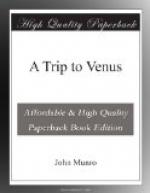“If the planetoids were born of a single small ring, might not several planets be condensed from a large one?”
“I see nothing to hinder it. A large ring might split into smaller rings, or condense in several centres.”
“Because it seems to me that might explain the distinction between the inner and the outer planets. Perhaps the outer were first thrown off in one immense ring, and then the inner in a smaller ring. Before separation the nebula viewed edgewise might resemble your Indian club.”
“A ‘dumb-bell nebula,’ like those we find in the heavens,” observed Gazen. “Be that as it may, the rings would collect into balls, and some of these, especially the outer, would cast off rings which would condense into moons, always excepting the rings of Saturn, which, like the planetoids, are evidently a failure. The solar system would then appear as a group of suns, a cluster of stars, in short, a constellation. Each would be what we call a ‘nebulous star,’ not unlike the sun at present; that is to say, it would be surrounded by a glowing atmosphere of vapours, and perhaps meteoric matter. Under the action of gravity, centrifugal force, and tidal retardation, their orbits would become more circular, they would gradually move further apart, rotate more slowly on their axes, and assume the shapes they have now. In cooling down, new chemical compounds, and probably elements would be formed, since the so-called elements are perhaps mere combinations of a primordial substance which have been produced at various temperatures. The heavier elements, such as platinum, gold, and iron, would sink towards the core; and the lighter, such as carbon, silicon, oxygen, nitrogen, and hydrogen, would rise towards the surface. A crust would form, and portions of it breaking in or bursting out together with eruptions and floods of molten lava, would disturb the poise of the planet, and give rise to inequalities of surface, to continents, and mountains. When the crust was sufficiently stable, sound, and cool, the mists and clouds would condense into rivers, lakes, or seas, and the atmosphere would become clear. In due course life would make its appearance.”




